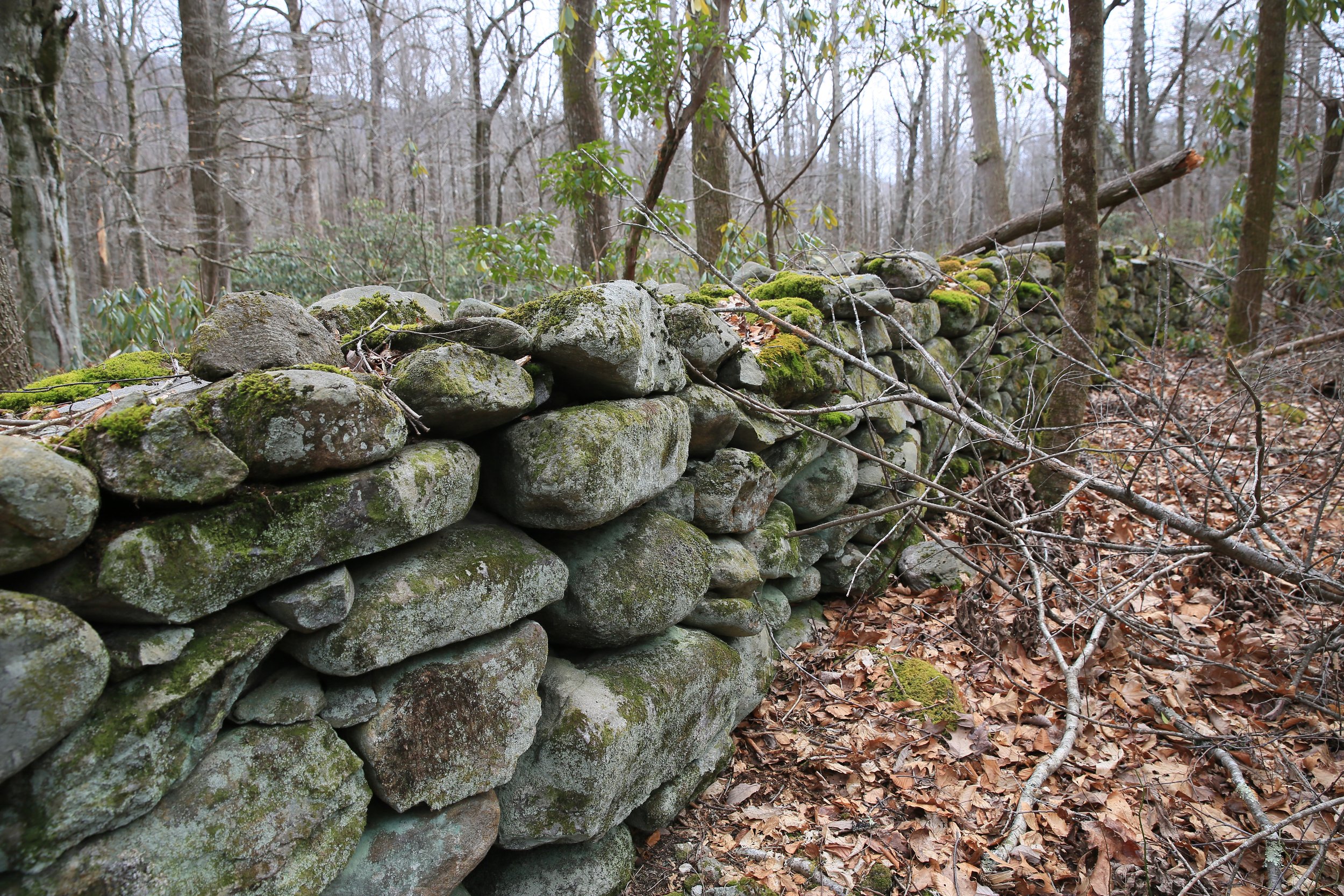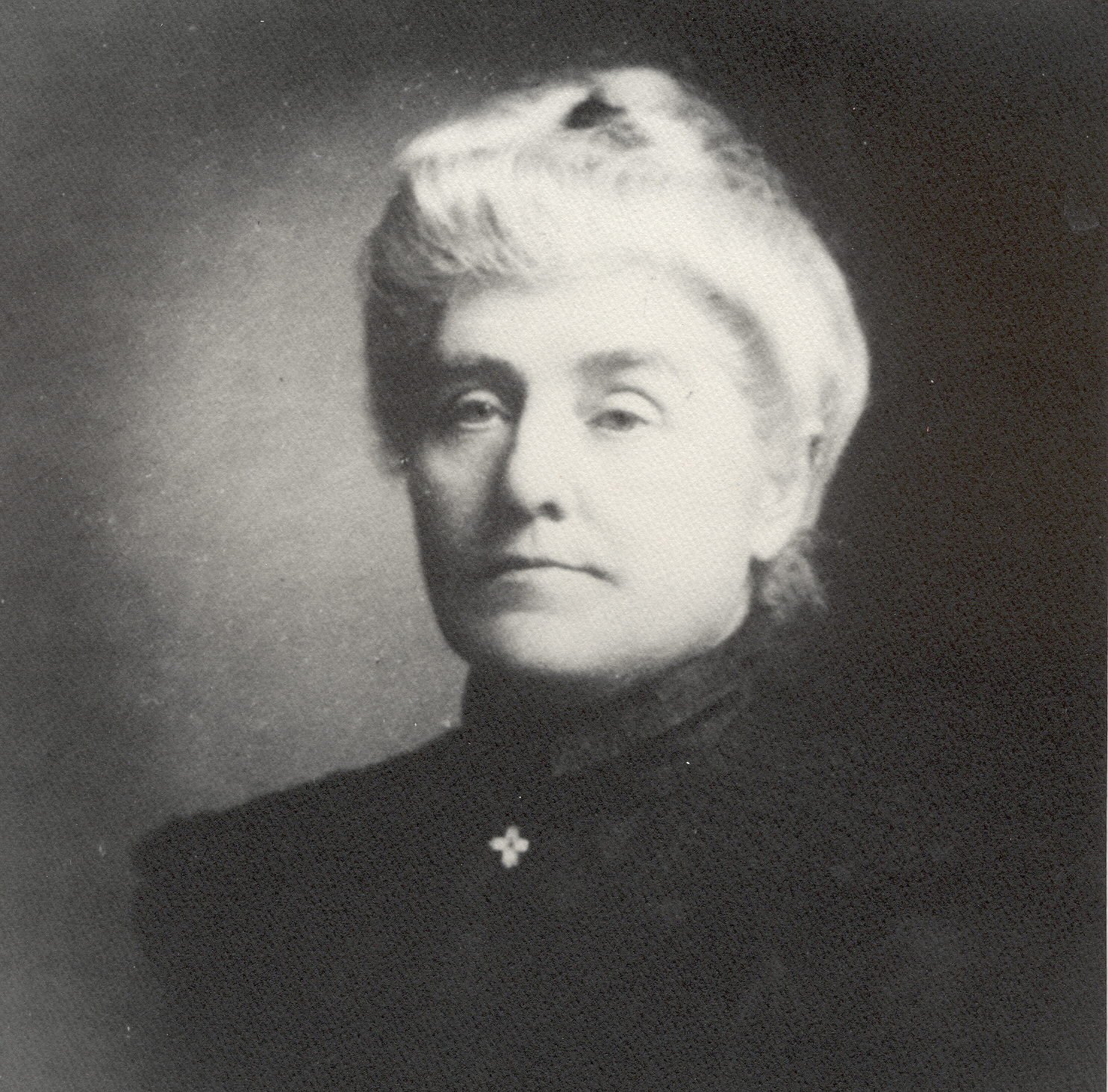Black Mountain's Past
Where Gombroon once stood, a love story remains
Wendell Begley
Guest contributor
The Valley Echo
May 3, 2024
Famously known as the Gombroon Wall, this massive wall of stone followed Vance’s lower property boundary along the North Fork of the Swannanoa River from the entrance to the estate to near the Daniel “Dan” Burnett (1836-1899) homeplace, a distance of approximately one mile. In my opinion, this is one of the most spectacular/largest relics of history to be found anywhere in the Swannanoa Valley. Bascombe Burnett (1882-1966), a direct descendant of pioneer stock (family Burnet) who was raised near Gombroon, said the following of the Senator ...“Vance was good to the folks on the North Fork. Work was mighty scarce about the time I remember (1880s), and the Senator had a stone wall built around his property just to give people work. He paid 80 cents per day for a ten-hour day.” Photo courtesy of the Wendell Begley Collection
With spring in the air, birds singing and daffodils peeping from the ground, one could say love, beauty and happiness abound. That stated, I have written a series on romance, devotion, and a legendary piece of history connected to the North Fork Valley.
The story line reveals a little known slice of local history. The narrative is tied to one of North Carolina’s most well-known governors and the unyielding affection shown toward his new bride. As seasons go, I believe it is as good of a story of a blossoming “spring-time” love affair as I can put to pen. The time was almost 144 years ago and the place was deep inside the wilderness of today’s Asheville Watershed Boundary. More specifically, the celebrated setting was on a brief plateau high above the rock strewn river bed known as the Big Left Hand Fork of the North Fork of the Swannanoa River. From downtown Black Mountain … well, it’s 5.6 miles (by-way-the-crow-flies) due north. Back then the special knoll was called Martin’s Hill .
So here goes …
This is a 1890s picture of Zeb and Florence’s endearing “Gombroon.” If readers look closely, you will see a “white” object immediately in front of the house just beyond the front steps. That was the famous “heart shaped” fountain.
During the fall of 1981 (43 years ago), in the company of my old friend and then Asheville Watershed superintendent Dean Yancey, we located the Gombroon ruins. We spent several hours digging through layers and layers of decayed leaves and soil to find and uncover the Senator’s near century old “heart shaped” pool and fountain (See Photo with heart shaped laid rocks and shovel standing at the location of the water fountain’s spout). It was an unforgettable experience and brought to life the legend of the Senator’s steadfast love and devotion for his “Lady.” Gombroon, the name chosen by Mrs. Vance, was said to have meant “Heart’s Desire” or “A Place of Dreams!” As a historical side-bar, in the September 17, 1892 edition of the Asheville Citizen Times, journalist Bill Nye wrote, after interviewing Ms. Vance, that she stated the name “Gombroon” originated from English essayist, Thomas De Quincey (1785-1859). Stating that “he” (De Quincey) “had conquered, owned and ruled a distant island called Gombroon.” Photo courtesy of the Wendell Begley Collection
By 1886, the “Washington Home on the Craggys” or Gombroon, as it was more widely known, was reputed to be one of the South’s most famous private residences and served as the background for one of North Carolina’s most endearing love stories. It was the palatial home of North Carolina’s beloved three-term Governor and U.S. Senator, Zebulon Baird “Zeb” Vance (1830-1894) and his Kentuckian bride, Florence Steele Martin (1840-1924).
A rare photograph of Florence Steele Martin, believed to have been taken in the 1890s. In her day, she was characterized as a lady of wealth, attractive presence and manners with high intellectual and social qualities. Photo courtesy of the Wendell Begley Collection
This is one of my favorite pictures of Zebulon Baird “Zeb” Vance. Zeb was born on May 13, 1830 in Buncombe County and died April 14, 1894 in Washington, D.C. He died at a young age of 64. Photo courtesy of the Wendell Begley Collection
When finally completed, the Victorian country house was a magnificent three story, 13-room structure situated on approximately 1,500 acres of real estate. Most of the property covered the drainage of the Little Left Hand Fork that’s situated between Craggy Dome and Bull’s Head. In published accounts from that era, the grand domain was described as one of the most picturesque in all of Western North Carolina. From the Senator’s porch, one was afforded spectacular views of the majestic ranges of the Craggys, Blacks and Blue Ridge (the Swannanoa Rim).
A photo I took nine years ago of my “ole buddy,” Van Burnette in 2015. Van is spreading the word about his North Fork ancestors to Museum guests at Vance’s mile-long Gombroon Wall. Van’s great, great, great uncle Daniel “Dan” Burnett (1836-1899), was the “care-taker” of the Gombroon estate when the Vances were away in Washington, D.C. Photo courtesy of the Wendell Begley Collection
Construction on the home began not long after the Vances were married on June 16, 1880 (Zeb’s first wife of 27 years, Harriett Espy, had died in 1878). While serving in the U.S. Senate, both the Senator and Mrs. Vance desired a retreat back home in the Western North Carolina mountains where they could relax and enjoy each other’s company. Not surprisingly, their new home and sprawling acreage was located just over the ridge on the opposite side of the Craggys from where the Senator was born and raised (Reems Creek Valley).
A photograph I took in March 2015 highlighting a Swannanoa Valley Museum sponsored adventure deep into the wilds of North Fork’s Asheville Watershed. The location was the site of the Gombroon ruins. The picture features our own Bert Brown singing a few local ballads he wrote about the North Fork Valley. Interestingly, Bert is standing near Vance’s “heart shaped pond” at the front of the house where a brief set of steps led to Gombroon’s celebrated doorway. Another sidebar … In the early 1950s Bert’s Dad (Bob Brown, 1927-2013) was long-time Superintendent of the vast acreage known as the Asheville Watershed. Photo courtesy of the Wendell Begley Collection
The residence was designed, constructed and furnished under the watchful care of both Zeb and Florence. While under lengthy construction, the Vances built a temporary log cabin nearby and lived there until the mansion was ready.
Newspapers of the day reported the splendid place to be a reflection of the couple’s abiding love and devotion. In 1886, as the home was nearly ready for occupancy, the Senator built a small “heart shaped” fountain on the grassy slope immediately in front of the house. He dedicated the fountain to Mrs. Vance saying it was to be a lasting symbol of his unyielding love.
During the fall of 1981 (43 years ago), in the company of my old friend and then Asheville Watershed superintendent Dean Yancey, we located the Gombroon ruins. We spent several hours digging through layers and layers of decayed leaves and soil to find and uncover the Senator’s near century old “heart shaped” pool and fountain (See photo above with heart shaped laid rocks and shovel standing at the location of the water fountain’s spout). It was an unforgettable experience and brought to life the legend of the Senator’s steadfast love and devotion for his “Lady.”
Gombroon, the name chosen by Mrs. Vance, was said to have meant “Heart’s Desire” or “A Place of Dreams!” As a historical side-bar, in the September 17, 1892 edition of the Asheville Citizen Times, journalist Bill Nye wrote, after interviewing Mrs. Vance, that she stated the name “Gombroon” originated from English essayist, Thomas De Quincey (1785-1859). Stating that “he” (De Quincey) “had conquered, owned and ruled a distant island called Gombroon.”
Black Mountain Savings Bank
P.O. Box 729 • 200 East State Street • Black Mountain, NC 28711 • 1.828.669.7991
“Established in 1908, We are One of the 47 Oldest FDIC Insured Banks in America” (that’s Out of 4,620 FDIC Insured Banks) …Too, We are the Town’s Oldest Continuing Business and the Only “Community Owned Bank.” We Have Been Taking Savings Deposits and Making “Local Home Loans” for 116 Years”
Copyright: M. Wendell Begley, series 877, VE13, May 3, 2024









